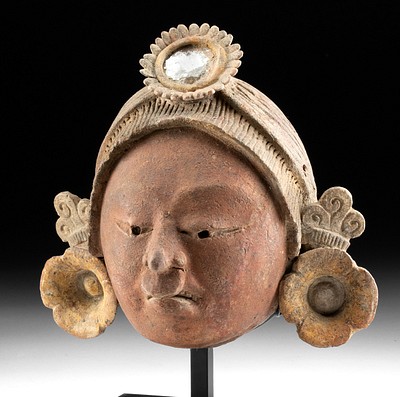Large 20th C. Skookum Composition Store Display Doll
Lot 156a
About Seller
Artemis Gallery
686 S Taylor Ave, Ste 106
Louisville, CO 80027
United States
Selling antiquities, ancient and ethnographic art online since 1993, Artemis Gallery specializes in Classical Antiquities (Egyptian, Greek, Roman, Near Eastern), Asian, Pre-Columbian, African / Tribal / Oceanographic art. Our extensive inventory includes pottery, stone, metal, wood, glass and textil...Read more
Categories
Estimate:
$2,000 - $3,000
Absentee vs Live bid
Two ways to bid:
- Leave a max absentee bid and the platform will bid on your behalf up to your maximum bid during the live auction.
- Bid live during the auction and your bids will be submitted real-time to the auctioneer.
Bid Increments
| Price | Bid Increment |
|---|---|
| $0 | $25 |
| $300 | $50 |
| $1,000 | $100 |
| $2,000 | $250 |
| $5,000 | $500 |
| $10,000 | $1,000 |
| $20,000 | $2,500 |
| $50,000 | $5,000 |
| $100,000 | $10,000 |
| $200,000 | $20,000 |
About Auction
By Artemis Gallery
Jul 14, 2022
Set Reminder
2022-07-14 10:00:00
2022-07-14 10:00:00
America/New_York
Bidsquare
Bidsquare : Exceptional Antiquities Ethnographica Fine Art
https://www.bidsquare.com/auctions/artemis-gallery/exceptional-antiquities-ethnographica-fine-art-9692
Museum-worthy examples of classical antiquities (Egyptian, Greek, Roman, Near Eastern), Viking, Far East / Asian, Pre-Columbian, African / Tribal, Oceanic, Native American, Spanish Colonial, Fossils, Ancient Jewelry, Fine / Visual Arts, so much more! Artemis Gallery info@artemisgallery.com
Museum-worthy examples of classical antiquities (Egyptian, Greek, Roman, Near Eastern), Viking, Far East / Asian, Pre-Columbian, African / Tribal, Oceanic, Native American, Spanish Colonial, Fossils, Ancient Jewelry, Fine / Visual Arts, so much more! Artemis Gallery info@artemisgallery.com
- Lot Description
**This is an oversized piece that may require special shipping. Please inquire for a quote prior to bidding.
North America, United States, ca. early 20th century CE. A child sized figure known as a Skookum, an early form of this collectible doll that was used as a store display to advertise Skookums. The detail in this doll is exquisite, he is constructed with a wooden frame covered with cotton cloth stuffed with straw and a wood pulp / papier-mache (composition) head complete with human hair braids, a colorful felt shawl, leather moccasins, feather, and heishi shell jewelry. Under the shawl the stuffed arms are crossed and pinned in place to his clothing; a floral cotton smock and skirt with felt appliques. This realistic rendering is also a prize-winning example; pinned to the shawl is a first-place winner ribbon from the September 11th, 1971, Western Relic Show in San Jose, California and the verso has the entry tag for the doll category judged by Fred Allen. Size: 7" L x 13" W x 37" H (17.8 cm x 33 cm x 94 cm)
Mary McAboy (1876 to 1961) was an American dollmaker of European descent who began her career hand carving apple head dolls but soon switched to a composite material of wood pulp and flour. The Skookum name comes from Chinook slang for strong or mighty, and the company slogan was "Bully Good." The dolls were patented by McAboy in 1913 and produced by H.H. Tammen Company. Dolls made after 1940 were plastic- this is an earlier example likely made around 1913 to 1918, indicated by the composition: papier-mache and wood pulp head, human hair, and leather moccasins. The later mid-20th century dolls were plastic or had composition feet and mohair wigs. The costumes were loosely styled after Plains and Southwestern tribes such as Pueblo and Sioux- the heishi shell necklace indicates a Southwestern Native person. McAboy oversaw the production of these dolls and was the head of Skookum assembly, until her retirement in 1952.
Provenance: private Covington, Louisiana, USA collection
All items legal to buy/sell under U.S. Statute covering cultural patrimony Code 2600, CHAPTER 14, and are guaranteed to be as described or your money back.
A Certificate of Authenticity will accompany all winning bids.
PLEASE NOTE: Due to recent increases of shipments being seized by Australian & German customs (even for items with pre-UNESCO provenance), we will no longer ship most antiquities and ancient Chinese art to Australia & Germany. For categories of items that are acceptable to ship to Australia or Germany, please contact us directly or work with your local customs brokerage firm.
Display stands not described as included/custom in the item description are for photography purposes only and will not be included with the item upon shipping.
#169894Cracking and losses to leather moccasins with tearing along seams. Losses to human hair braids and fraying to feather. Staining and discoloration to shawl and cotton clothing.Condition
- Shipping Info
-
All shipping is handled in-house for your convenience. Your invoice from Artemis Gallery will include shipping calculation instructions. If in doubt, please inquire BEFORE bidding for estimated shipping costs for individual items.
-
- Buyer's Premium



 EUR
EUR CAD
CAD AUD
AUD GBP
GBP MXN
MXN HKD
HKD CNY
CNY MYR
MYR SEK
SEK SGD
SGD CHF
CHF THB
THB
















